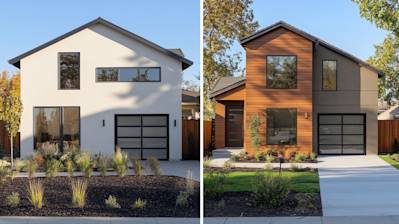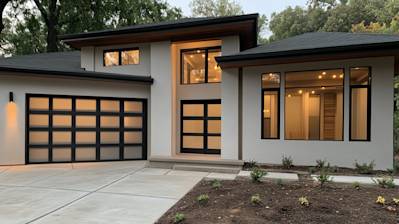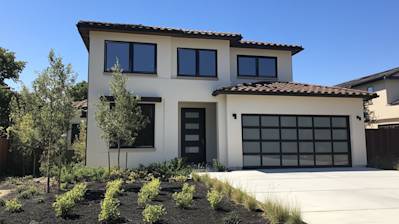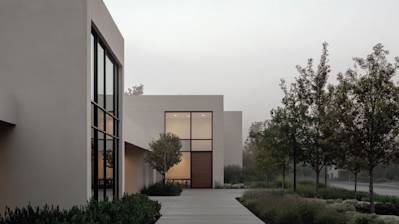If you're in the market for a new home or considering a renovation of your existing property, you may have come across the terms 'stucco' and 'plaster'. Often, people tend to use these terms interchangeably, leading to some confusion about what each of these materials entails and how they are utilized in construction projects. Understanding the differences between stucco and plaster will help you make informed decisions about the right material to use in your specific case. So, let's delve deeper into the world of 'stucco vs plaster'.
Understanding Stucco
Stucco is a type of protective and decorative surface material. It is made from Portland cement, sand, lime, and water. Generally, it is applied in three coats over a wire framework called a lath. This material provides a durable, low-cost, and versatile option that easily adheres to numerous outdoor applications—ranging from home façades and garden walls to other structural surfaces.
Characteristics of Stucco
- Excellent durability and longevity
- Resistance to fire, rot, and mold
- Provision of a seamless home exterior
Unraveling Plaster
Plaster, on the other hand, has a historical charm and is more frequently used in indoor applications. It is traditionally made from lime, sand, and water. The modern version of plaster, commonly known as gypsum plaster, includes a mixture of gypsum, water, and sand. As a material, plaster brings a smooth and polished texture and can be sculpted into decorative moldings.
Attributes of Plaster
- Favorable for interior finishing
- Ability to create sound and thermal insulation
- Suitable for molding into diverse shapes
Stucco vs Plaster: Highlighting Differences
Given the composition and typical applications of stucco and plaster, we can highlight some notable differences between these two materials.
Material Composition
The primary difference between stucco and plaster lies in their compositions. While both stucco and plaster require water and sand, stucco uses Portland cement for extra strength, whereas plaster uses gypsum or lime.
Application Area
Stucco is mostly used for exterior applications due to its resilience and weather-resistant characteristics, whereas plaster, being less resistant to moisture, is preferred for interiors.
Finish Types
Stucco can be left rough or can be smoothed out based on preferences and is used to cover less visually appealing construction materials. Plaster provides a smooth, hard surface that can be painted or left as is for a classic look.
Stucco vs Plaster: Making the Right Choice
Both stucco and plaster have their unique advantages which make them suitable for different situations. The choice between 'stucco' and 'plaster' primarily depends on where it will be applied and the aesthetic that you prefer.
In selecting between stucco and plaster, consider factors like the climate (stucco tends to favor dryer climates), the desired aesthetic, and where the material will be applied (indoor vs. outdoor). By considering these factors, you can find out whether stucco vs plaster would work best for your specific needs.
Regardless of the material you choose, both stucco and plaster applications should be done by a skilled professional. Proper application ensures the longevity of the material, reduces the potential for cracks, and provides a quality finish.
While 'stucco vs plaster' can seem like a daunting subject, we hope this article has helped clear up the differences between these two commonly used building materials and made your decision-making process a tad easier. Remember, whether you choose stucco or plaster, both materials have proven their worth in the building industry and provide excellent options for creating beautiful, durable surfaces.
Frequently Asked Questions About Stucco vs Plaster
Which material is more durable, stucco or plaster?
When considering durability in the stucco vs plaster comparison, stucco typically secures the winning position. Known for its weather resistance and longevity, stucco can last up to 50 years with proper maintenance. Plaster, while also durable, is more susceptible to dings and scratches since it's usually applied indoors.
Are there any difference in costs between stucco and plaster?
Costs can vary greatly between stucco and plaster, mainly depending on the labor rates in your area. In general, stucco is more expensive than plaster due to its more complex installation process. However, considering its durability and low maintenance requirements, some homeowners find it to be a cost-effective choice in the long run.
Can stucco be used indoors like plaster?
While typically seen on exterior walls, stucco can technically be used indoors. However, it's rarely the material of choice for interior surfaces due to its rough texture and the superior finish and detail achievable with plaster.
How are the maintenance needs of stucco different from plaster?
In the stucco vs plaster discussion, maintenance is another differentiator. Stucco requires minimal maintenance - a new paint job every 5 to 6 years, and a check for cracks or chips annually. Plaster, while also low-maintenance, may need more frequent repainting or touch-ups due to its susceptibility to dents and scratches.
What is the installation process like for stucco vs plaster?
The installation process also differs in the stucco vs plaster comparison. Plaster application involves applying several thin layers to a backing and allowing each to dry before applying the next. Stucco requires a similar process, but the final layer is typically textured and additional layers of wire and sheathing may need to be applied beforehand for stronger adherence.
When should I choose stucco over plaster, and vice versa?
The choice between stucco and plaster comes down to the requirements of your project. If you're looking for an exterior finish that's durable, weather resistant, and gives a rustic charm, stucco would be ideal. If it's an interior job requiring smooth walls and decorative detailing, plaster may be a superior choice.
Is it easy to repair stucco compared to plaster?
Repair procedures for both stucco and plaster can be straightforward, but require a skilled hand to maintain consistency with existing surfaces. Damage to plaster tends to be easier to address, as it's usually contained to smaller, indoor areas. Stucco repairs can be more complex, requiring an exact match in texture and color for a seamless result.
Can I DIY stucco or plaster installation?
While industrious homeowners can certainly attempt DIY stucco or plaster installation, these jobs generally require a professional touch. Both stucco and plaster installations can be labor-intensive processes requiring craftsmanship to achieve the desired finish, making hiring a professional contractor often the best choice for most homeowners.
How does the aesthetic appeal of stucco compare to plaster?
When it comes to aesthetic appeal in the stucco vs plaster debate, the choice is largely subjective. Stucco lends a rustic, southwestern charm and can be finished in a variety of textures. Plaster, on the other hand, is known for its smooth finish and can accommodate a wide range of decorative features and detailing.
Pros and Cons of Stucco Vs Plaster
Pros of Stucco
-
Durability:
Stucco is incredibly durable and can last several decades if properly maintained. It's designed to withstand harsh weather conditions, and it's even fire-resistant, making it an excellent choice for homes in areas prone to wildfires. -
Ease of Maintenance
Stucco requires minimal maintenance. Due to its durability, stucco generally needs only an occasional hose down to remove dust and dirt. -
Design Flexibility:
With stucco, you have a broad range of options when it comes to colors and textures. Stucco can be customized to any style, from rustic to modern, making it a versatile choice for any home design. -
Energy Efficiency:
Stucco is considered an excellent insulator of both cold and warm air. This insulation can help keep your home cool in the summer and warm in the winter, potentially reducing your energy costs.
Cons of Stucco
-
Cost:
The initial installation cost of stucco can be quite high, especially compared to other siding options. This pricing is due to the labor-intensiveness of applying stucco, as it requires several coats. -
Damages:
While stucco is quite durable, it's not entirely damage-proof. Stucco can crack if your home's foundation shifts. When damaged, the repair process can be costly and complicated. -
Moisture Sensitivity:
Stucco can absorb water, causing it to soften and disintegrate over time. Therefore, it's not recommended for regions with high precipitation without additional waterproofing measures.
Pros of Plaster
-
Durability:
Like stucco, plaster walls are designed to last for an exceptionally long time. They provide a hard, durable surface that can resist damage from impacts that would normally damage ordinary walls. -
Customization:
Plaster allows for more intricate and detailed designs than drywall. You can mold it into various shapes and sizes and use pigments to color it, which allows for unique architectural details. -
Soundproofing:
Plaster walls provide excellent soundproofing. The thickness of plaster helps prevent noise from traveling into or out of a room, making it a suitable option for locations that require noise reduction, such as music studios or home theaters.
Cons of Plaster
-
Installation process:
The installation process for plaster can be more time-consuming and laborious compared to other wall finishes. Plaster requires a particular skill set, driving up labor costs. -
Repairs:
Although plaster is durable, when it does crack or get damaged, repairs can be difficult. Matching new plaster to old installed plaster for seamless repair is a specialized task. -
Cost:
The cost of installing plaster walls can exceed other options, such as drywall, due to its labor-intensive installation and the cost of the materials.
Summary
Doing home renovations can be challenging, especially when it comes to choosing between stucco and plaster. After examining all the pros and cons, it is clear that both stucco and plaster have their own unique benefits. If you're looking for a material that is incredibly durable and can withstand harsh weather conditions, then stucco would be the perfect choice. On the other hand, if you are more interested in a classic and smooth finish, then plaster would be your best bet.
The choice between stucco vs plaster largely depends on your personal taste and the specific requirements of your project. Both materials are versatile and can be used both indoors and outdoors. Stucco lends a rustic and textured appeal, while plaster gives a polished and elegant look. Furthermore, stucco could provide a better thermal barrier for the walls keeping them cooler in summer and warmer in winter, while plaster provides a seamless finish that can easily be painted over to match any interior decor.
Finally, cost can be a deciding factor in your stucco vs plaster decision. Stucco tends to be more affordable and easier to apply, making it an excellent option if you're on a tight budget or if you're tackling a large project. Plaster, while often more expensive, provides a level of sophistication and refinement that could increase the value of your home. So, no matter which material you choose, both stucco and plaster have the potential to elevate your home's appearance and functionality.
About Atlas Stucco
Welcome to Atlas Stucco, your top-rated stucco service in Sacramento, CA! We've been adding texture and style to buildings across the region since our establishment. We specialize in stucco installation, repair, and renovation - consistently delivering quality and durability layered with aesthetic appeal. With Atlas Stucco, you'll not only experience professionalism and expert craftsmanship, but also a commitment to customer satisfaction. It's our combination of skill, passion, and attention to detail that sets us apart. Let us help you bring your vision to life!
Tags: stucco vs plaster, building materials, construction,








